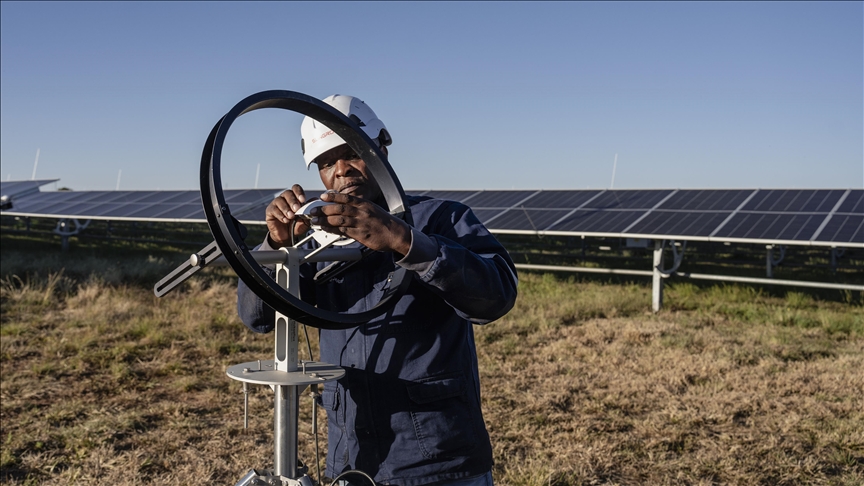Here comes the sun: Africa bets big on solar energy
Africa’s solar panel imports have surged over the past year, a sign that large-scale expansion is underway across the continent

- Africa’s solar panel imports have surged over the past year, a sign that large-scale expansion is underway across the continent
- ‘Much of Africa’s solar growth so far has been driven by utility-scale projects, including large installations and smaller mini-grid systems in villages and towns,’ says Dave Jones of energy think tank Ember
- ‘This revolution is starting to happen now, and the citizens within the countries are ready to start taking steps to make change for themselves,’ says expert
ISTANBUL
It started quietly. A few panels on school rooftops, a glint of glass in remote villages, a pilot project buried in an NGO report.
But over the past two decades, solar power has moved from the periphery to the center of Africa’s energy story.
Long seen as too costly or complex for widespread use, solar energy is now lighting up homes, powering clinics, and driving businesses across the continent. With costs falling, technologies improving, and demand for affordable power surging, Africa’s energy future looks set to rise with the sun.
Global energy think tank Ember recently analyzed export data from China’s General Administration of Customs (GACC), describing it as “the first evidence of a take-off in solar in Africa.”
Over the past year alone, solar panel imports into the continent have surged, a sign that large-scale expansion is underway.
“Much of Africa’s solar growth so far has been driven by utility-scale projects, including large installations and smaller mini-grid systems in villages and towns,” Dave Jones, director of Ember’s Global Insights Program, told Anadolu.
He cited Algeria as a standout case, with solar panel imports rising 33-fold in a year, making it Africa’s third-largest importer.
But growth is not confined to big projects, as many countries without major utility-scale projects are seeing rising imports too, Jones said, reflecting a global trend where households, businesses, and government buildings increasingly install solar panels to generate their own power.
Solar power rises
Ember’s report found that solar panel imports from China to Africa jumped 60% in the past year, nearly tripling outside South Africa, with 20 African countries hitting record highs.
Yet the surge also underscores reliance on Chinese supply, as local manufacturing capacity remains limited.
“Like so many other places in the world, domestic solar manufacturing capacity is stepping up,” Jones explained. “It’s just a bit behind the curve on demand, and you’ve seen that in so many countries.”
Some governments are trying to close that gap. Morocco, Egypt, and South Africa are leading efforts to expand local production, while India is seen as a model for reducing dependence on Chinese imports.
Other countries are scaling up projects to boost renewables. In Benin, Axian Energy and local firm Sika Capital recently announced four new photovoltaic plants totaling 60 MW, aimed at lifting renewables to 30% of the electricity mix by 2030, up from 16% today.
“The value that’s bringing to the economy is really helping,” Jones said. “It eclipses the value of the solar panel imports themselves.”
Cutting diesel reliance with fast payback
Diesel generators remain a lifeline for electricity across much of Africa – but also a costly crutch.
Jones highlighted that in Africa’s top 10 solar-importing countries, diesel imports exceed solar imports by a factor of 30 to 100. Yet solar panels, he stressed, can pay for themselves in as little as six months.
“Most countries in Africa are importers of especially refined fuels,” he said. “Even Nigeria, which is a massive crude oil producer, has no refining capacity and imports all of its diesel requirements, which is absurd.”
Jones said many African countries rely heavily on diesel imports, but refined product exporters such as Algeria stand to gain by freeing up fuel for export.
He also pointed to Saudi Arabia as an example: one of the top solar installers last year, it is replacing oil-fired plants with solar to export more oil at higher profits.
‘Revolution is starting to happen’
Historically, solar in Africa has centered on micro-scale uses such as irrigation and lighting, said Jones, but the sector is now diversifying.
Namibia is hosting large green hydrogen projects backed by European buyers, while mid-sized applications like air conditioning are emerging as critical growth areas.
“The need for air conditioning in Africa is hugely unmet,” Jones said, adding solar is the “perfect fit” where diesel generators or costly grid electricity were once the only options.
With international solar panel prices at historic lows – some panels cost as little as $60 in African markets – Jones emphasized the importance of keeping imports flowing and recognizing the broader economic gains.
“This revolution is starting to happen now, and the citizens within the countries are ready to start taking steps to make change for themselves,” he said.
He warned, however, that governments often hesitate, pushing back and halting progress without looking at the bigger picture.
Nigeria offers a cautionary tale, Jones said, where authorities initially planned to ban solar imports but reversed course after realizing the economic harm. Infrastructure, he stressed, must also keep pace to support the shift.
Anadolu Agency website contains only a portion of the news stories offered to subscribers in the AA News Broadcasting System (HAS), and in summarized form. Please contact us for subscription options.







